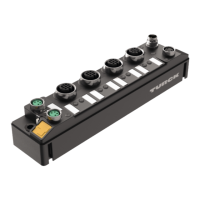V01.00 | 2019/10
63
8.9 Commissioning the device in EtherNet/IP™
8.9.1 Common EtherNet/IP™ features
Features Description
QuickConnect No
Device Level Ring (DLR) yes
Number of TCP connections 3
Number of CIP connections 10
Input assembly instance 103, 120, 121, 122, 123,124, 125
Output assembly instance 104, 150, 151, 152
Configuration assembly Instance 106
8.9.2 EDS files and catalog files
The EDS and catalog files can be downloaded free of charge from www.turck.com.
n TBEN-S_ETHERNETIP.zip
8.9.3 Device Level Ring (DLR)
The devices support DLR. The Device Level Ring (DLR)-redundancy protocol is used to increase
the stability of EtherNet/IP™ networks. DLR-capable products provide an integrated switch and
can thus be integrated into a ring topology. The DLR-protocol is used to recognize a ring fault.
If the data line ins interrupted, data are sent through an alternative network section, so that the
network can be reconfigured as soon as possible. DLR-capable network nodes are provided
with extended diagnostic functions which enable the devices to localize errors and thus de-
crease the time for error search and maintenance.
8.9.4 Diagnostic messages via process data
The diagnostic messages of the IO-Link channels are directly mapped into the process data
[}116].
Additionally, the device's status word contains the module diagnostics.
8.9.5 EtherNet/IP™ standard classes
The modules support the following EtherNet/IP™ Standard Classes in accordance with the CIP
specification.
Class Code Object name
Dec. Hex.
01 0x01 Identity Object [}64]
04 0x04 Assembly Object [}66]
06 0x06 Connection Manager Object [}79]
245 0xF5 TCP/IP Interface Object [}80]
246 0xF6 Ethernet Link Object [}83]

